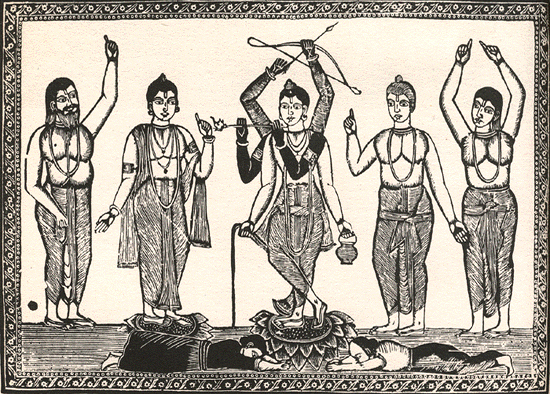Calcutta Woodcuts #2
BY: SUN STAFF

Sri Pancha Tattva
Dec 14, USA (SUN) — It is now universally recognized that the art of printing from wooden blocks on cloth or paper began in the Eastern Hemisphere. Stone and burnt clay were used along with wood printing. Fabric printing with wooden blocks appeared early in India, and in Egypt by the sixth and seventh centuries. Extant specimens from two thousand years before Christ are known. Other notable examples are mentioned from the 4th century A.D.
In China, the Diamond Sutra was block-printed in the area around the Cave of the Thousand Buddhas, near Tun-Huang, around 868 AD. Blocks were also used in handwritten manuscripts well before that time in China.
Museums in India contain many examples of rock and copper plate inscriptions. Old documents also contain other forms of engraving, such as the marks of royal seals. In India, the earliest example of block printing on paper date much more recently than the Chinese. Paper only came to be used extensively in India around the thirteenth century, about the same time Europe began using paper. While not popularly used, paper was known to be used in India as early as the sixth and seventh centuries AD. Prior to that, examples of Indian block-printing on fabrics are available from at least as early as the fourth century AD.
With both paper and block printing known in the country, it is somewhat surprising that Indians didn't produce multiple manuscripts of Vedic text and images with blocks until much later. This may be due to the fact that transcription was tightly controlled by the Brahmans, who often worked as temple priests under the royal courts. Their work was very different from that produced by the common populace, who were not supported by patrons. Consequently, the common people continued to produce manually handwritten manuscripts well beyond the time other technologies were available.
In today's series, we have an exquisite example of Bengali woodblock printing depicting Lord Caitanya's Pancha Tattva. The engraver of this piece is unknown, as is the case with so many of these rare Calcutta woodblock cuts. The piece may have been done, however, by Hiralal Karmakar.
The woodcut measures 36 by 25 cms. Framed with a typical floral motif border, we see Lord Caitanya as an incarnation of Rama and Krishna, six-armed, holding bow, flute and paraphernalia. By their dress, we can see that the devotees paying obeisances at their feet are common people, representing Lord Caitanya's merciful spreading of the Holy Names to all fallen jivatmas.
The artist has portrayed the unique personalities of the five Divine persons by posture, facial expression, hair, and paraphernalia. There is also a beautiful rendition of the five unique personalities depicted in the variously tied dhotis they wear.
